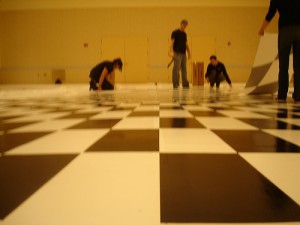 A Swedish study found that the rate of autism is higher for children in houses that have PVC vinyl flooring. The children in the study were apparently affected by the phthalates that are emitted from the material.
A Swedish study found that the rate of autism is higher for children in houses that have PVC vinyl flooring. The children in the study were apparently affected by the phthalates that are emitted from the material.
Infants and toddlers who had vinyl floors in their rooms were twice as likely to develop autism spectrum disorder (ASD) than those with wood or aluminum floors.
The PVC floors were one of four links the researchers discovered. The other three are maternal smoking, poor ventilation, and family financial stress. The children with ASD were also more likely to have asthma.
As you may remember, back in January a study by UC Davis said that the 7- to 8-fold increase in the cases of ASD could not be attributed to better detection. Rather,
It’s time to start looking for the environmental culprits responsible for the remarkable increase in the rate of autism.
This would be one of those environmental factors, no?
Lucky for us and our children, phthalates have been banned from children’s toys and feeding gear. Obviously, there are still other avenues for exposure.
As an answer to this study, the Center for Health, Environment, & Justice is mounting a campaign to remove the chemical-laden flooring from schools. Of course, we should also hope they’re removed from daycares and other early childhood facilities.
Researchers also say that this “baffling” link should be studied further. These results are far from conclusive.
The asthma-phthalate link has certainly been demonstrated in studies before. This PVC-autism link surely warrants more investigation as part of a broader look into the numerous environmental factors for ASD.
The study is published in the journal Neurotoxicology.
Image: danielle_blue on Flickr under a Creative Commons License.
This “link” was discovered quite accidentally. Your readers should keep in mind that correlation DOES NOT equal causation. Referenced study shows no demonstrable (and repeatable) causation of autism by PVC or phthalate plasticizers.
“The asthma-phthalate link has certainly been demonstrated in studies before.” Not really if one takes time to read the studies in question. To assert this is to misrepresent the facts. Those previous studies are also cases of conflating correlation with causation.
In the end, all you are doing is needlessly causing concern and fear among parents. Not to mention giving far more credit than is deserved to intellectual and scientific bankrupts such as CHEJ and their ilk.
I’ve tried to respond to you a few times, Johnny, but for some reason my comment keeps getting lost in Word Press.
FWIW, I did highlight, “These results are far from conclusive.” I thought that might be enough to show people that correlation is not causation. I certainly trust in the readers here to be educated enough to read what I write and make their own decisions.
I don’t believe that there is any one thing that causes ASD. Rather, it is a mix of environmental and genetic causes. I believe that is also what the UC Davis researchers who published the California study also think is worth delving into.
I also don’t put all my eggs in the CHEJ basket, as it were. I simply thought that having a few links to different studies might be helpful for those who want to read further on the matter.
Perhaps this one, from the NIH, might help:
http://www.ncbi.nlm.nih.gov/pubmed/15471731
Or these, from other sources. They may help people get on the path to delving deeper if they so choose:
http://www.scribd.com/doc/6428931/The-Role-of-Exposure-to-Phthalates-from-Polyvinyl-Chloride-Products-in-the-Development-of-Asthma-and-Allergies-A-Systematic-Review-and-Metaanalysis
And these, from enviro groups (who often rely on governmental studies)
http://www.enviroblog.org/2008/04/phthalate-induced-asthma-gasping-for-breath.html
http://www.ourstolenfuture.org/NewScience/oncompounds/phthalates/2006/2006-1107jaakkolaetal.html
In any case, I don’t feel I’m “needlessly causing concern.” Phthalates are a problem, period. The worry about asthma is only one problem. If you want to go ahead and defend something that has been linked to a shorter androgenital distance (not too mention numerous other hormonal issues), please. By all means, be my guest.
More study should be done about this chemical and the many others we constantly expose our children to.
How to meet the Nutritional, Social & Emotional needs of a child in the setting who has Celiac Disease? How to adapt activities and experiences involving food, interacting with other children at meal and snack time and working with Parents.